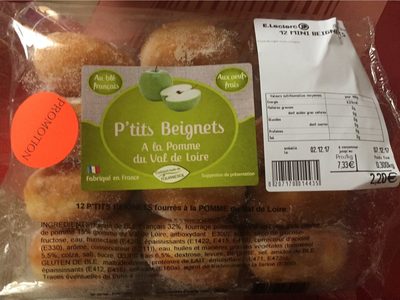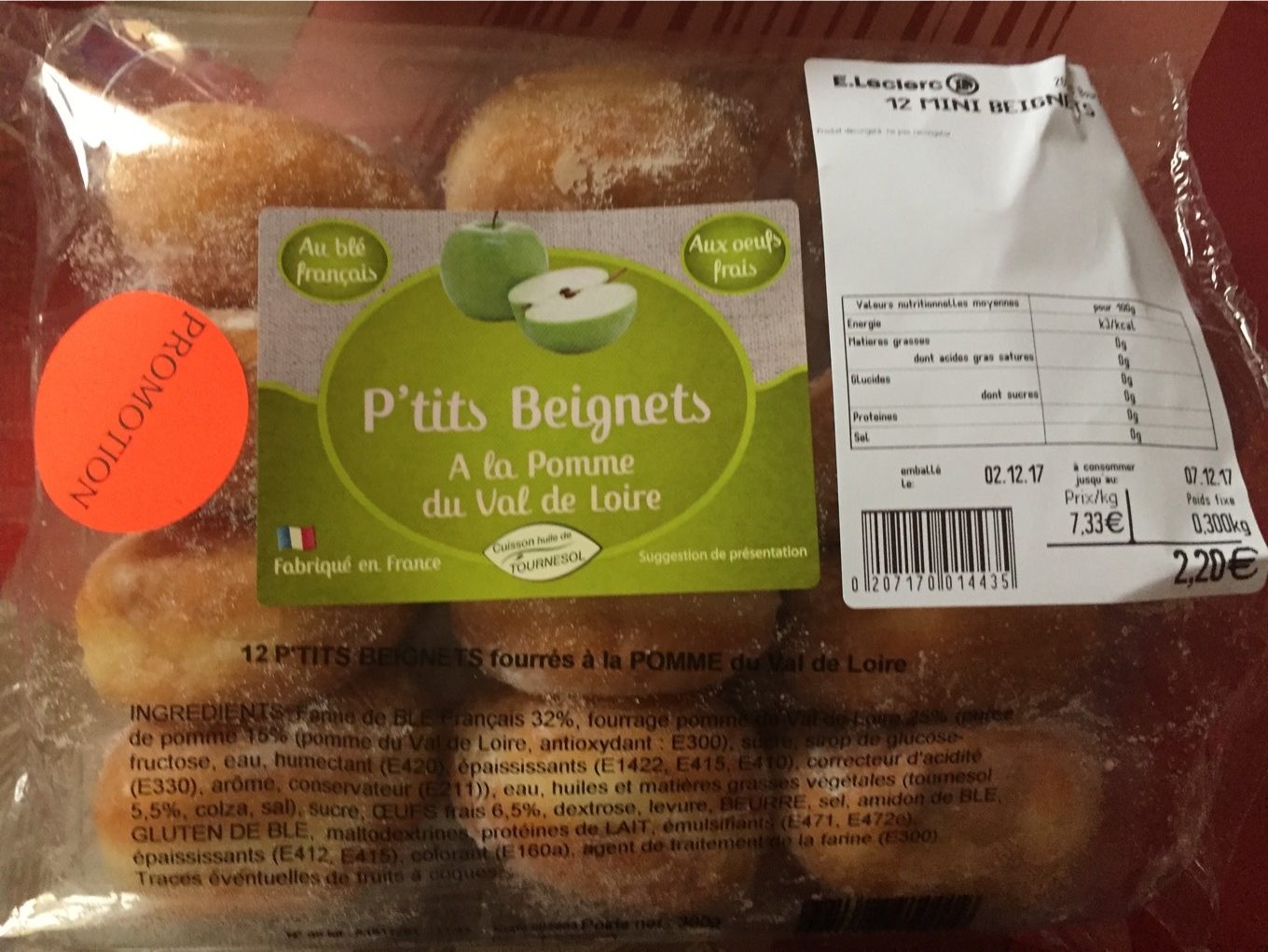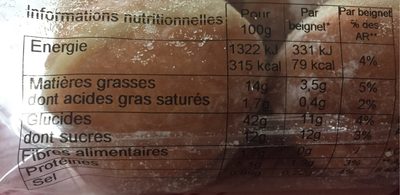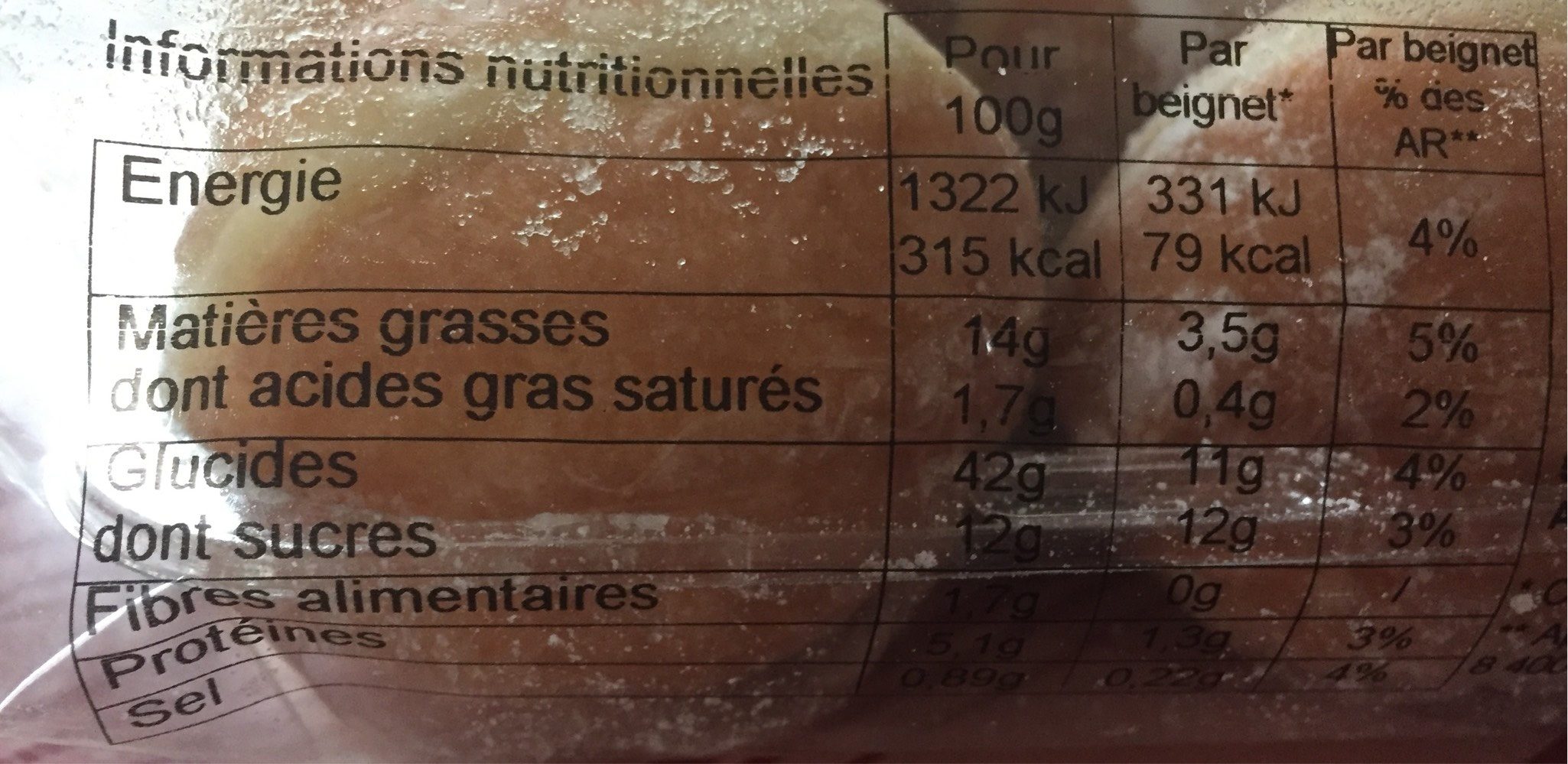Help us make food transparency the norm!
As a non-profit organization, we depend on your donations to continue informing consumers around the world about what they eat.
The food revolution starts with you!
12 P’tits Beignets à la Pomme du Val de Loire - Leclerc - 300 g
12 P’tits Beignets à la Pomme du Val de Loire - Leclerc - 300 g
This product page is not complete. You can help to complete it by editing it and adding more data from the photos we have, or by taking more photos using the app for Android or iPhone/iPad. Thank you!
×
Barcode: 0207170014435 (EAN / EAN-13) 207170014435 (UPC / UPC-A)
Common name: Beignets fourrés à la purée de pomme
Quantity: 300 g
Packaging: Plastic, Bag, Unfrozen
Brands: Leclerc
Categories: Snacks, Sweet snacks, Sweet Fritters
Labels, certifications, awards:
Green Dot, Made in France, fr:Blé français, fr:Farine de blé français
Origin of ingredients: France
Manufacturing or processing places: France
Stores: Leclerc
Countries where sold: France
Matching with your preferences
Health
Ingredients
-
45 ingredients
: Farine de blé français 32%, fourrage pomme du Val de Loire 25% (purée de pomme 15% (pomme du Val de Loire, antioxydant E300), sucre, sirop de glucose-fructose, eau, humectant (E420), épaississants (E1422, E415, E410), correcteur d'acidité (E330), arôme, conservateur (E211)), eau, huiles et matières grasses végétales (tournesol 5,5%, colza, sal), sucre, ŒUFS frais, dextrose, levure, BEURRE, sel, amidon de blé, GLUTEN DE BLE, maltodextrines, protéines de LAIT, émulsifiants (E471, E472e) épaississants (E412, E415), colorant (E160a), agent de traitement de la farine (E300).Allergens: Eggs, Gluten, MilkTraces: Nuts
Food processing
-
Ultra processed foods
Elements that indicate the product is in the 4 - Ultra processed food and drink products group:
- Additive: E1422 - Acetylated distarch adipate
- Additive: E160a - Carotene
- Additive: E410 - Locust bean gum
- Additive: E412 - Guar gum
- Additive: E415 - Xanthan gum
- Additive: E420 - Sorbitol
- Additive: E471 - Mono- and diglycerides of fatty acids
- Additive: E472e - Mono- and diacetyltartaric acid esters of mono- and diglycerides of fatty acids
- Ingredient: Colour
- Ingredient: Dextrose
- Ingredient: Emulsifier
- Ingredient: Flavouring
- Ingredient: Glucose
- Ingredient: Gluten
- Ingredient: Humectant
- Ingredient: Maltodextrin
- Ingredient: Milk proteins
- Ingredient: Thickener
Food products are classified into 4 groups according to their degree of processing:
- Unprocessed or minimally processed foods
- Processed culinary ingredients
- Processed foods
- Ultra processed foods
The determination of the group is based on the category of the product and on the ingredients it contains.
Additives
-
E1422 - Acetylated distarch adipate
Acetylated distarch adipate: Acetylated distarch adipate -E1422-, is a starch that is treated with acetic anhydride and adipic acid anhydride to resist high temperatures. It is used in foods as a bulking agent, stabilizer and a thickener. No acceptable daily intake for human consumption has been determined.Source: Wikipedia
-
E160a - Carotene
Carotene: The term carotene -also carotin, from the Latin carota, "carrot"- is used for many related unsaturated hydrocarbon substances having the formula C40Hx, which are synthesized by plants but in general cannot be made by animals -with the exception of some aphids and spider mites which acquired the synthesizing genes from fungi-. Carotenes are photosynthetic pigments important for photosynthesis. Carotenes contain no oxygen atoms. They absorb ultraviolet, violet, and blue light and scatter orange or red light, and -in low concentrations- yellow light. Carotenes are responsible for the orange colour of the carrot, for which this class of chemicals is named, and for the colours of many other fruits, vegetables and fungi -for example, sweet potatoes, chanterelle and orange cantaloupe melon-. Carotenes are also responsible for the orange -but not all of the yellow- colours in dry foliage. They also -in lower concentrations- impart the yellow coloration to milk-fat and butter. Omnivorous animal species which are relatively poor converters of coloured dietary carotenoids to colourless retinoids have yellowed-coloured body fat, as a result of the carotenoid retention from the vegetable portion of their diet. The typical yellow-coloured fat of humans and chickens is a result of fat storage of carotenes from their diets. Carotenes contribute to photosynthesis by transmitting the light energy they absorb to chlorophyll. They also protect plant tissues by helping to absorb the energy from singlet oxygen, an excited form of the oxygen molecule O2 which is formed during photosynthesis. β-Carotene is composed of two retinyl groups, and is broken down in the mucosa of the human small intestine by β-carotene 15‚15'-monooxygenase to retinal, a form of vitamin A. β-Carotene can be stored in the liver and body fat and converted to retinal as needed, thus making it a form of vitamin A for humans and some other mammals. The carotenes α-carotene and γ-carotene, due to their single retinyl group -β-ionone ring-, also have some vitamin A activity -though less than β-carotene-, as does the xanthophyll carotenoid β-cryptoxanthin. All other carotenoids, including lycopene, have no beta-ring and thus no vitamin A activity -although they may have antioxidant activity and thus biological activity in other ways-. Animal species differ greatly in their ability to convert retinyl -beta-ionone- containing carotenoids to retinals. Carnivores in general are poor converters of dietary ionone-containing carotenoids. Pure carnivores such as ferrets lack β-carotene 15‚15'-monooxygenase and cannot convert any carotenoids to retinals at all -resulting in carotenes not being a form of vitamin A for this species-; while cats can convert a trace of β-carotene to retinol, although the amount is totally insufficient for meeting their daily retinol needs.Source: Wikipedia
-
E211 - Sodium benzoate
Sodium benzoate: Sodium benzoate is a substance which has the chemical formula NaC7H5O2. It is a widely used food preservative, with an E number of E211. It is the sodium salt of benzoic acid and exists in this form when dissolved in water. It can be produced by reacting sodium hydroxide with benzoic acid.Source: Wikipedia
-
E330 - Citric acid
Citric acid is a natural organic acid found in citrus fruits such as lemons, oranges, and limes.
It is widely used in the food industry as a flavor enhancer, acidulant, and preservative due to its tart and refreshing taste.
Citric acid is safe for consumption when used in moderation and is considered a generally recognized as safe (GRAS) food additive by regulatory agencies worldwide.
-
E410 - Locust bean gum
Locust bean gum: Locust bean gum -LBG, also known as carob gum, carob bean gum, carobin, E410- is a thickening agent and a gelling agent used in food technology.Source: Wikipedia
-
E412 - Guar gum
Guar gum (E412) is a natural food additive derived from guar beans.
This white, odorless powder is valued for its remarkable thickening and stabilizing properties, making it a common ingredient in various food products, including sauces, dressings, and ice creams.
When used in moderation, guar gum is considered safe for consumption, with no known adverse health effects.
-
E415 - Xanthan gum
Xanthan gum (E415) is a natural polysaccharide derived from fermented sugars, often used in the food industry as a thickening and stabilizing agent.
This versatile food additive enhances texture and prevents ingredient separation in a wide range of products, including salad dressings, sauces, and gluten-free baked goods.
It is considered safe for consumption even at high intake amounts.
-
E420 - Sorbitol
Sorbitol: Sorbitol --, less commonly known as glucitol --, is a sugar alcohol with a sweet taste which the human body metabolizes slowly. It can be obtained by reduction of glucose, which changes the aldehyde group to a hydroxyl group. Most sorbitol is made from corn syrup, but it is also found in nature, for example in apples, pears, peaches, and prunes. It is converted to fructose by sorbitol-6-phosphate 2-dehydrogenase. Sorbitol is an isomer of mannitol, another sugar alcohol; the two differ only in the orientation of the hydroxyl group on carbon 2. While similar, the two sugar alcohols have very different sources in nature, melting points, and uses.Source: Wikipedia
-
E471 - Mono- and diglycerides of fatty acids
Mono- and diglycerides of fatty acids (E471), are food additives commonly used as emulsifiers in various processed foods.
These compounds consist of glycerol molecules linked to one or two fatty acid chains, which help stabilize and blend water and oil-based ingredients. E471 enhances the texture and shelf life of products like margarine, baked goods, and ice cream, ensuring a smooth and consistent texture.
It is generally considered safe for consumption within established regulatory limits.
Ingredients analysis
-
May contain palm oil
Ingredients that may contain palm oil: E471, E472e, E160a
-
Non-vegan
Non-vegan ingredients: Fresh egg, Butter, Milk proteinsSome ingredients could not be recognized.
We need your help!
You can help us recognize more ingredients and better analyze the list of ingredients for this product and others:
- Edit this product page to correct spelling mistakes in the ingredients list, and/or to remove ingredients in other languages and sentences that are not related to the ingredients.
- Add new entries, synonyms or translations to our multilingual lists of ingredients, ingredient processing methods, and labels.
If you would like to help, join the #ingredients channel on our Slack discussion space and/or learn about ingredients analysis on our wiki. Thank you!
-
Vegetarian status unknown
Unrecognized ingredients: fr:fourrage-pomme-du-val-de-loire, fr:pomme-du-val-de-loireSome ingredients could not be recognized.
We need your help!
You can help us recognize more ingredients and better analyze the list of ingredients for this product and others:
- Edit this product page to correct spelling mistakes in the ingredients list, and/or to remove ingredients in other languages and sentences that are not related to the ingredients.
- Add new entries, synonyms or translations to our multilingual lists of ingredients, ingredient processing methods, and labels.
If you would like to help, join the #ingredients channel on our Slack discussion space and/or learn about ingredients analysis on our wiki. Thank you!
-
Details of the analysis of the ingredients
We need your help!
Some ingredients could not be recognized.
We need your help!
You can help us recognize more ingredients and better analyze the list of ingredients for this product and others:
- Edit this product page to correct spelling mistakes in the ingredients list, and/or to remove ingredients in other languages and sentences that are not related to the ingredients.
- Add new entries, synonyms or translations to our multilingual lists of ingredients, ingredient processing methods, and labels.
If you would like to help, join the #ingredients channel on our Slack discussion space and/or learn about ingredients analysis on our wiki. Thank you!
: Farine de _blé_ français 32%, fourrage pomme du Val de Loire 25% (purée de pomme 15% (pomme du Val de Loire, antioxydant (e300)), sucre, sirop de glucose-fructose, eau, humectant (e420), épaississants (e1422, e415, e410), correcteur d'acidité (e330), arôme, conservateur (e211)), eau, huiles et matières grasses végétales (tournesol 5.5%, colza, sal), sucre, _ŒUFS_ frais, dextrose, levure, _BEURRE_, sel, amidon de _blé_, _GLUTEN DE BLE_, maltodextrines, protéines de _LAIT_, émulsifiants (e471, e472e), épaississants (e412, e415), colorant (e160a), agent de traitement de la farine (e300)- Farine de _blé_ français -> en:wheat-flour - labels: fr:farine-de-ble-francais - vegan: yes - vegetarian: yes - ciqual_proxy_food_code: 9410 - percent_min: 32 - percent: 32 - percent_max: 32
- fourrage pomme du Val de Loire -> fr:fourrage-pomme-du-val-de-loire - percent_min: 25 - percent: 25 - percent_max: 25
- purée de pomme -> en:apple-puree - vegan: maybe - vegetarian: maybe - ciqual_food_code: 13050 - percent_min: 15 - percent: 15 - percent_max: 15
- pomme du Val de Loire -> fr:pomme-du-val-de-loire - percent_min: 7.5 - percent_max: 15
- antioxydant -> en:antioxidant - percent_min: 0 - percent_max: 7.5
- e300 -> en:e300 - vegan: yes - vegetarian: yes - percent_min: 0 - percent_max: 7.5
- sucre -> en:sugar - vegan: yes - vegetarian: yes - ciqual_proxy_food_code: 31016 - percent_min: 1.25 - percent_max: 10
- sirop de glucose-fructose -> en:glucose-fructose-syrup - vegan: yes - vegetarian: yes - ciqual_food_code: 31077 - percent_min: 0 - percent_max: 8.33333333333333
- eau -> en:water - vegan: yes - vegetarian: yes - ciqual_food_code: 18066 - percent_min: 0 - percent_max: 4.375
- humectant -> en:humectant - percent_min: 0 - percent_max: 2.91666666666667
- e420 -> en:e420 - vegan: yes - vegetarian: yes - percent_min: 0 - percent_max: 2.91666666666667
- épaississants -> en:thickener - percent_min: 0 - percent_max: 2.1875
- e1422 -> en:e1422 - vegan: yes - vegetarian: yes - percent_min: 0 - percent_max: 2.1875
- e415 -> en:e415 - vegan: yes - vegetarian: yes - percent_min: 0 - percent_max: 1.09375
- e410 -> en:e410 - vegan: yes - vegetarian: yes - percent_min: 0 - percent_max: 0.729166666666667
- correcteur d'acidité -> en:acidity-regulator - percent_min: 0 - percent_max: 1.75
- e330 -> en:e330 - vegan: yes - vegetarian: yes - percent_min: 0 - percent_max: 1.75
- arôme -> en:flavouring - vegan: maybe - vegetarian: maybe - percent_min: 0 - percent_max: 1.45833333333333
- conservateur -> en:preservative - percent_min: 0 - percent_max: 1.25
- e211 -> en:e211 - vegan: yes - vegetarian: yes - percent_min: 0 - percent_max: 1.25
- purée de pomme -> en:apple-puree - vegan: maybe - vegetarian: maybe - ciqual_food_code: 13050 - percent_min: 15 - percent: 15 - percent_max: 15
- eau -> en:water - vegan: yes - vegetarian: yes - ciqual_food_code: 18066 - percent_min: 5.5 - percent_max: 25
- huiles et matières grasses végétales -> en:vegetable-oil-and-fat - vegan: yes - vegetarian: yes - from_palm_oil: maybe - percent_min: 5.5 - percent_max: 16.5
- tournesol -> en:sunflower - vegan: yes - vegetarian: yes - percent_min: 5.5 - percent: 5.5 - percent_max: 5.5
- colza -> en:colza-oil - vegan: yes - vegetarian: yes - from_palm_oil: no - ciqual_food_code: 17130 - percent_min: 0 - percent_max: 5.5
- sal -> en:sal-tree - vegan: yes - vegetarian: yes - percent_min: 0 - percent_max: 5.5
- sucre -> en:sugar - vegan: yes - vegetarian: yes - ciqual_proxy_food_code: 31016 - percent_min: 0.107142857142857 - percent_max: 12
- _ŒUFS_ frais -> en:fresh-egg - vegan: no - vegetarian: yes - ciqual_food_code: 22000 - percent_min: 0 - percent_max: 9.34821428571428
- dextrose -> en:dextrose - vegan: yes - vegetarian: yes - ciqual_proxy_food_code: 31016 - percent_min: 0 - percent_max: 7.47857142857143
- levure -> en:yeast - vegan: yes - vegetarian: yes - percent_min: 0 - percent_max: 6.23214285714286
- _BEURRE_ -> en:butter - vegan: no - vegetarian: yes - ciqual_proxy_food_code: 16400 - percent_min: 0 - percent_max: 5.34183673469388
- sel -> en:salt - vegan: yes - vegetarian: yes - ciqual_food_code: 11058 - percent_min: 0 - percent_max: 0.89
- amidon de _blé_ -> en:wheat-starch - vegan: yes - vegetarian: yes - ciqual_proxy_food_code: 9510 - percent_min: 0 - percent_max: 0.89
- _GLUTEN DE BLE_ -> en:wheat-gluten - vegan: yes - vegetarian: yes - percent_min: 0 - percent_max: 0.89
- maltodextrines -> en:maltodextrin - vegan: yes - vegetarian: yes - percent_min: 0 - percent_max: 0.89
- protéines de _LAIT_ -> en:milk-proteins - vegan: no - vegetarian: yes - percent_min: 0 - percent_max: 0.89
- émulsifiants -> en:emulsifier - percent_min: 0 - percent_max: 0.89
- e471 -> en:e471 - vegan: maybe - vegetarian: maybe - from_palm_oil: maybe - percent_min: 0 - percent_max: 0.89
- e472e -> en:e472e - vegan: maybe - vegetarian: maybe - from_palm_oil: maybe - percent_min: 0 - percent_max: 0.445
- épaississants -> en:thickener - percent_min: 0 - percent_max: 0.89
- e412 -> en:e412 - vegan: yes - vegetarian: yes - percent_min: 0 - percent_max: 0.89
- e415 -> en:e415 - vegan: yes - vegetarian: yes - percent_min: 0 - percent_max: 0.445
- colorant -> en:colour - percent_min: 0 - percent_max: 0.89
- e160a -> en:e160a - vegan: maybe - vegetarian: maybe - from_palm_oil: maybe - percent_min: 0 - percent_max: 0.89
- agent de traitement de la farine -> en:flour-treatment-agent - percent_min: 0 - percent_max: 0.89
- e300 -> en:e300 - vegan: yes - vegetarian: yes - percent_min: 0 - percent_max: 0.89
en:wheat -> en:wheat
en:wheat-flour -> en:wheat-flour
Nutrition
-
Average nutritional quality
⚠ ️Warning: the amount of fruits, vegetables and nuts is not specified on the label, it was estimated from the list of ingredients: 17This product is not considered a beverage for the calculation of the Nutri-Score.
Positive points: 4
- Proteins: 3 / 5 (value: 5.1, rounded value: 5.1)
- Fiber: 1 / 5 (value: 1.7, rounded value: 1.7)
- Fruits, vegetables, nuts, and colza/walnut/olive oils: 0 / 5 (value: 17.75, rounded value: 17.8)
Negative points: 9
- Energy: 3 / 10 (value: 1318, rounded value: 1318)
- Sugars: 2 / 10 (value: 12, rounded value: 12)
- Saturated fat: 1 / 10 (value: 1.7, rounded value: 1.7)
- Sodium: 3 / 10 (value: 356, rounded value: 356)
The points for proteins are counted because the negative points are less than 11.
Nutritional score: (9 - 4)
Nutri-Score:
-
Nutrient levels
-
Fat in moderate quantity (14%)
What you need to know- A high consumption of fat, especially saturated fats, can raise cholesterol, which increases the risk of heart diseases.
Recommendation: Limit the consumption of fat and saturated fat- Choose products with lower fat and saturated fat content.
-
Saturated fat in moderate quantity (1.7%)
What you need to know- A high consumption of fat, especially saturated fats, can raise cholesterol, which increases the risk of heart diseases.
Recommendation: Limit the consumption of fat and saturated fat- Choose products with lower fat and saturated fat content.
-
Sugars in moderate quantity (12%)
What you need to know- A high consumption of sugar can cause weight gain and tooth decay. It also augments the risk of type 2 diabetes and cardio-vascular diseases.
Recommendation: Limit the consumption of sugar and sugary drinks- Sugary drinks (such as sodas, fruit beverages, and fruit juices and nectars) should be limited as much as possible (no more than 1 glass a day).
- Choose products with lower sugar content and reduce the consumption of products with added sugars.
-
Salt in moderate quantity (0.89%)
What you need to know- A high consumption of salt (or sodium) can cause raised blood pressure, which can increase the risk of heart disease and stroke.
- Many people who have high blood pressure do not know it, as there are often no symptoms.
- Most people consume too much salt (on average 9 to 12 grams per day), around twice the recommended maximum level of intake.
Recommendation: Limit the consumption of salt and salted food- Reduce the quantity of salt used when cooking, and don't salt again at the table.
- Limit the consumption of salty snacks and choose products with lower salt content.
-
-
Nutrition facts
Nutrition facts As sold
for 100 g / 100 mlCompared to: Sweet Fritters Energy 1,318 kj
(315 kcal)-13% Fat 14 g -15% Saturated fat 1.7 g -54% Carbohydrates 42 g -8% Sugars 12 g -28% Fiber 1.7 g +5% Proteins 5.1 g -20% Salt 0.89 g +21% Fruits‚ vegetables‚ nuts and rapeseed‚ walnut and olive oils (estimate from ingredients list analysis) 17.75 %
Environment
-
Eco-Score not computed - Unknown environmental impact
We could not compute the Eco-Score of this product as it is missing some data, could you help complete it?Could you add a precise product category so that we can compute the Eco-Score? Add a category
Packaging
-
Packaging with a medium impact
-
Packaging parts
Bag (Plastic)
-
Packaging materials
Material % Packaging weight Packaging weight per 100 g of product Plastic
-
Transportation
-
Origins of ingredients
Origins of ingredients with a medium impact
Origin of the product and/or its ingredients % of ingredients Impact France 100 %Medium
Report a problem
-
Incomplete or incorrect information?
Category, labels, ingredients, allergens, nutritional information, photos etc.
If the information does not match the information on the packaging, please complete or correct it. Open Food Facts is a collaborative database, and every contribution is useful for all.
Data sources
Product added on by kiliweb
Last edit of product page on by packbot.
Product page also edited by beniben, chevalstar, desan, openfoodfacts-contributors, yuka.YVpnNU92MFRxK2sydThCbitUaU15TTFhbU0vd2UyUHZFdXRJSVE9PQ.









